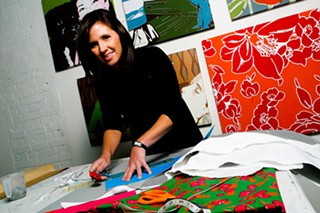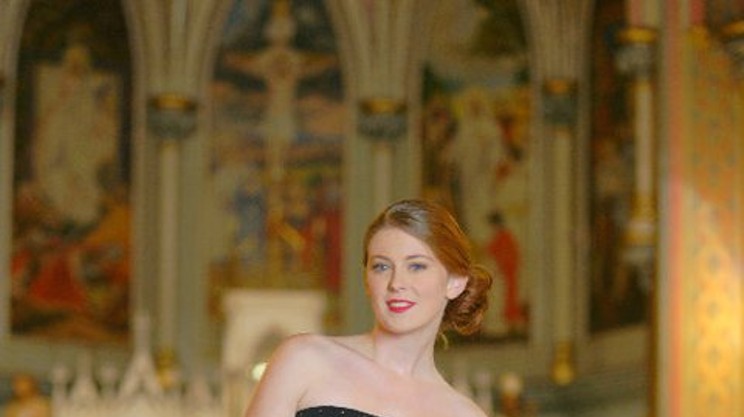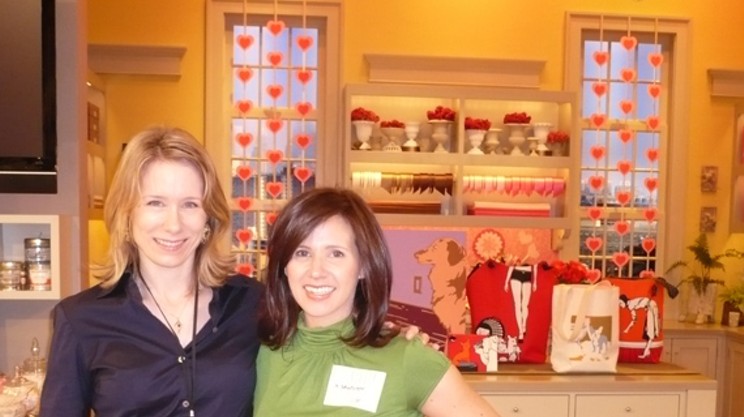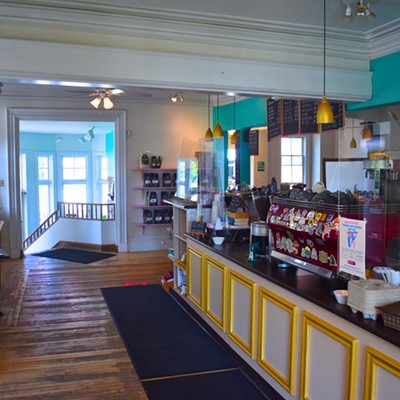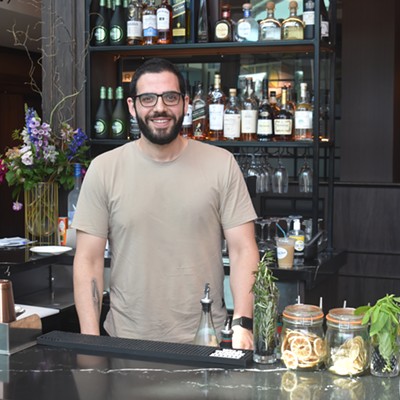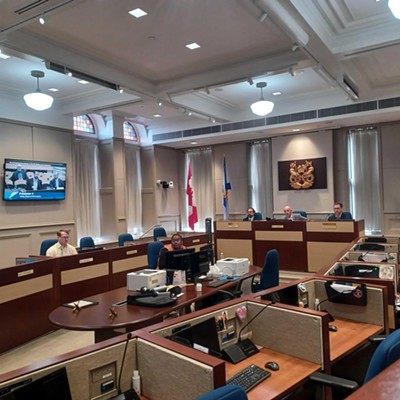Remember when you could heat up a pot of mac 'n' cheese and wieners for dinner and you didn't have to worry about whether the milk was organic, the cheese local or whether the pigs roamed freely? These days we spend a lot of time making appropriate food choices, buying from farmers' markets and checking labels, but we don't spend nearly as much time thinking about our clothes and where they come from. Really, does it make sense to eat your artisanal cheese while wearing an Old Navy sweater?
Clothing might seem frivolous when compared to the omnivore's dilemma, but it's not. Like food, everything you purchase clothing-wise has environmental, cultural and social consequences. But many of us would also rather stay home than wear a hand-woven hemp sack and Birkenstocks (no offense). Fashion should be fun and playful and expressive and creative. Good design should be democratic and available for all, not just the rich---and even the big stores are making moves: there's Isaac Mizrahi fashion at Target, avant-garde Comme des Garçons creating collections at H&M, and Jo Fresh (available at Atlantic Superstores) just showed their popular inexpensive lines at Toronto Fashion Week.
I know what you're thinking: "Lady, I live in Halifax. This ain't Milan." But while you've been daydreaming through the pages of Vogue, Atlantic Canadian fashion---quietly and modestly---is emerging into something special. Across the city, designers are sewing, patterning, screen-printing and marketing their clothing to local and international buyers. We have the education---NSCAD University has a thriving fashion program---boutique owners interested in supporting local designers, and more consumers who actually want to meet the person that made their skirt or hat. And now, starting Thursday, we have the first Atlantic Fashion Week.
In cities like Toronto or Montreal, fashion weeks are run by recognized fashion councils---a self-governing body that determines which designers will show their new collections to buyers, journalists, celebutantes and other style-types, and offers support for issues such as mentorship and copyright. But Halifax's inaugural week is a little out of the ordinary: It's produced by Angela Sotiropoulos, a Dal costume studies grad, former designer and owner of City Models. (Technically, this is the second week; there was an Atlantic Canada Fashion Week in September, organized by modelling agency competitor Strut International.) It's an ambitious event, with multiple nights of fashion shows, a masquerade party, DJs and even a professional set designer who has worked on major events like Toronto Pride.
"It seems as if it's taken the modelling industry in Halifax to light a fire under the entire industry. It's not typical---it's an anomaly. They're not run by modelling industries, but heck, no one else was getting things going. However it happens, it happens," says Lisa Drader-Murphy, who runs Turbine Clothing out of her design studio/cafe in Falmouth.
Drader-Murphy moved to Nova Scotia nine years ago and tried to "find people who did what I did," she says. "There wasn't a lot in terms of production-ready, so I created our own show." Last weekend Drader-Murphy hosted her own fashion preview event (the eighth annual) at Pier 21, and is also part of AFW, showing Saturday night.
In 2001, there was a fledgling local council called Fashion Nova Scotia, run by a small group including Drader-Murphy and Susan Hanrahan of the Nova Scotia Designer Crafts Council, but it didn't last. "I think it was a little too soon," Drader-Murphy says. "There just wasn't enough happening yet. So we thought we'd put this thing on hold for now and see what comes of it down the road. But I've seen more and more people coming here to study fashion and not just that, they're staying here. That's really exciting."
There's motivation now to get the council back in time for the spring, and Drader-Murphy praises Sotiropoulos for being open to their involvement in future events. "This inaugural week is kind of missing the guts of the design industry, but it's getting people's attention so they're turning around---Halifax? Fashion? It's not an oxymoron. A lot of people are interested. I want to support it in that. I want other people to look at our region and say, 'Look, they pulled that off, and they did OK.'"
Not so long ago, Gary Markle was joking with a student about creating a Halifax fashion long weekend. Markle is like the godfather of Halifax design: He studied at New York's Parsons School of Design (made famous by Project Runway and Markle's old prof, the lovable Tim Gunn), where, in 1988, he received a Golden Thimble award---an honour also held by Marc Jacobs, currently the creative director for Louis Vuitton (where he designed that awesome luggage in The Darjeeling Limited)---and was named student designer of the year. Markle is an assistant professor at NSCAD, where he took two months off last year to intern at one of Natalie Portman's favourite designers, Zac Posen, and has worked on numerous commissions, events and film sets. Last year Markle was artistic director for FashionEASTa, the ECMAs' fashion and music show, and five of his students are participating in Thursday night's runway. In other words, Markle's aware of the amount of work that goes into a fashion week.
"Ready or not, here it comes. We won't know how it will go until after it happens," he says cautiously. "But I am committed to the idea that this is the only way it's going to happen. I hope that people will be brought out of the woodwork and talk about what it can become."
Markle also hopes that AFW will reflect this region and not replicate Toronto or New York events. "It doesn't work. We can have a good time and a high-class quality event eventually like the jazz fest or the film festival or like the East Coast Music Awards. It's up to people in this region to stand up and say, 'What do we want to do to make this unique? What makes sense for here?'"
When Markle was in New York with Posen, he was pleasantly surprised when he realized his own thinking wasn't "light years behind." He says it's a reminder that "we're doing really well---it's like when you meet someone in Europe who really likes Joel Plaskett. It's different music than you might get out of Berlin but it's going to appeal to those people who get that aesthetic."
You can't ignore NSCAD's impact on local design. Markle suggests the school has the potential to become a powerful force, like the Antwerp Six---a group of designers who graduated from the city's Royal Academy of Fine Arts in 1980, and became influential avant-garde designers.
The students Markle works with have been attracted to NSCAD's strong conceptual arts focus, and are from a generation brought up to be environmentally aware. "Yet they're young enough that fashion is really, really important to them. There's still coming out of that whole 'this is my tribe, this is my sexual energy being broadcast into the world,' and fashion, that's one of its prime functions," he says. "That's creating a hybridized aesthetic as far as I can see. Equal parts avant-garde, fashion in the big-F sense and treehugger."
Several AFW designers are already creating fashionable, affordable clothes through sustainable means. There's Kim Munson's Orphanage Clothing, with her high-kicking, energetic, reconstructed vintage t-shirts and clothing (also one of the few local designers who makes men's wear). Anna Gilkerson makes all her pretty Deux FM clothing out of reused, recycled and environmentally friendly materials such as lyocell (wood pulp cellulose) and soy. She even has a cute recycled linen/denim bikini. There's Tuttle & Leonardo, whose designs are feminine but edgy with unexpected twists and yet still locally minded.
If you've been in any downtown boutiques lately and checked the labels, chances are you've seen their clothing. But there are more designers showing at AFW who are testing the waters and hoping that one day you'll wear their clothes and accessories, too.
The entrepreneur: Michelle SaintOnge
Michelle SaintOnge must have one of the nicest studios in the city. An open-concept space in the coveted Creative Crossing building on Argyle, it's bright and airy. A long piece of cloth, hand-printed with bunches of lush cherries, lies stretched across a long table. To the uninformed, it's gorgeous, but SaintOnge is not happy with the colours and so it will be set aside for smaller projects she might sell on etsy.com, the popular online handcraft marketplace.
For AFW, SaintOnge is launching a collection of entirely handmade silkscreened bags that can only be described as darling. Inspired by her art (SaintOnge also does custom pet portraits: think Warhol meets Fluffy), these colourful bags---in clutch, handbag and weekender sizes---feature the cherry prints and naughty chihuahuas at play, in retro styles and bright hues. Although they're not printed yet, SaintOnge, also a commercial textile artist who's worked for studios in Paris and New York, pulls up designs for garment bags on her laptop. They will have a herringbone pattern, with graphics of clothing on hangers---the women's has a dress and heels, the men's a suit and shoes (including a pair of Converse). They're the kind of bags that will get you stopped on the street or in the airport.
She's still figuring out how she wants to present her bags on the catwalk. SaintOnge has put together a lookbook that will act as a guide. She says it has a Betsey Johnson feel, reflecting the bags' aesthetic, which she calls "fun and optimistic. Slightly nostalgic."
At AFW, SaintOnge wants to introduce the line and talk about what it means to make handmade goods. Right now the bags are available as limited editions, but she is researching costs to have them mass-produced, either offshore or through a Canadian producer. Currently, economies of scale and lack of locally available materials makes them impossible to produce here. But it's daunting: Not only do you have to worry about foreign ethical practices, but also copyright protection laws, so SaintOnge hopes to find a mentor with this type of experience. So far no luck: "It's an awful lot of options, but not really a lot of direction."
Meanwhile, SaintOnge is selling online on her website (michellesaintonge.com), taking marketing classes and starting a blog, Print Cut Sew, that will offer free tutorials for silkscreening. She's also waiting to hear back from the Martha Stewart Showabout a potential future appearance.
The activist: Laura Chenoweth
On the other side of the Creative Crossing building, Laura Chenoweth prepares for her Saturday AFW show out of her small studio that currently acts as a showroom. Two racks of clothing reveal warm, earthy colours---forest green, pretty plum, fire-ember orange. The styles are classic---fitted but relaxed. Like SaintOnge, Chenoweth's collection is a reflection of her own aesthetic and lifestyle.
As a photographer, Chenoweth first went to India in 1995, where she became entranced with the gorgeous, indigenous fabrics. "My eye just started becoming trained towards uplifted textiles. You could see the same-old same-old everywhere but then my eye started picking up nicer quality." In 1998 she returned and took a trip to Rajasthan, where the textiles were made, and set up a partnership. For over 10 years she designed and her Indian partners produced duvet covers, curtains and home decor items, successfully selling them online.
After a break from that business, Cheno-weth realized there are other people like her who want to know where their clothing is made and are shocked by the devastation caused by traditional cotton growing. "I don't support producing things that pollute the environment for one, but also don't exploit the people in the production process," she says. "We all need to wear clothes and primarily what we wear is cotton, denim, corduroy, knitwear, weavewear: it's all cotton. Not to be an aggressive environmentalist, but there is a way we can wear clothes and be more conscious about it. Not just the habitual tendency of going to Winners or the Gap."
In her first collection, which she describes as "practical upbeat," Chenoweth has 10 styles made up of pants, handprinted dresses, tunics, shirts and nightgowns, designed in this studio and produced by Indian artisans who then ship the final pieces back to Halifax. Although all the pieces are made out of certified organic cotton with non-toxic dyes, Chenoweth's aware that she could be taken to task for her carbon footprint: "My reply is that I'm involved, they're involved, the cotton's certified. The shipping part I thought about, but I don't have the overhead to be able to produce in Canada. And I think unfortunately the price point is so high when it's produced in Canada, people fall back on big-box shopping because they can't afford it.
"I have a vision that conscious fashion could be afforded mainstream, that one could afford organic clothes and not kill your wallet."
But today, Chenoweth's biggest concern is her first model fitting and finding the right accessories to make her "classic, elegant, neutral" clothes stand out on the runway.
The artist: Akshay Tyagi
Akshay Tyagi is steaming his garments in the main hallway of NSCAD's Port Campus. The big pieces lie in a giant suitcase, avoiding the dusty floor. Beside it, a clear plastic jacket has been stitched with black thread to look like a communication tower (you can see it on the cover). Tyagi puts on a pair of long black pants that ripple like tubing and a yellow and grey tunic with flowing sleeves. Later, he'll try on a clear plastic cape-like piece that covers his face.
Tyagi, who organized the Wearable Art Show two years ago and was involved in FashionEASTa, is the product of his school and NSCAD's mindfulness towards conceptual thinking. Growing up in India, Tyagi wanted to go to London or New York for art school, but as an international student, the tuition was so expensive, he didn't even tell his parents that he didn't send in the applications. Then he met Sharon Murray, who was in India on a NSCAD off-campus independent study. She convinced him that NSCAD was perfect.
For AFW, Tyagi is presenting his grad-show pieces---a personal collection that reflects on his cultural identity, but is also "an exploration of form, structure, different materials and of concept. It sounds art-speak but that's what it is." He wants to see how they translate from gallery to runway, as eventually Tyagi envisions turning the designs into a women's collection. "I want to see them on bodies, I want to see them in motion, I want to see them all at once. I can let go just to see what happens."
He was surprised but pleased that Sotiropoulos decided to have an emerging designer night on Thursday, that will allow "people to see the higher end of fashion, almost to the level of couture in some ways. If you look at collections now, the ready-to-wear, they're using PVC, rubbers and plastics, it's pretty amazing." But Tyagi also knows that this type of presentation, outside of the safety of the NSCAD community, comes with risks, too. Even finding models and preparing for the fittings is a challenge.
"I don't think that the models quite know the full scope of it," he says. "Last Sunday I took one piece. They're strutting in their walk and the jaw lines---'you know you're not doing that at the show.'"
Tyagi isn't making a living off his designs just yet, although he's recently been commissioned to create 25 pieces for a new women's choir. Right now he works full-time at Club Monaco as a visual manager, which helps him "get the psyche of the customer and the cycle of trend and season." It's tough for new grads: A lack of studio space and interning possibilities means that you have to find your own possibilities.
Still, he plans on waiting a long time before starting his own label. For now, Tyagi's only long-term goal is "hopefully surviving just off my design work and getting the skills down. I want to learn and intern and adapt and offer new insight. I just want to design, nice and simply. I just want to design."

